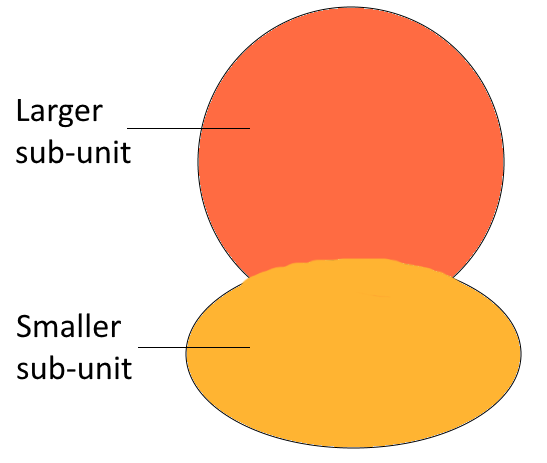
The site of protein synthesis is
a. Ribosomes
b. DNA
c. Nucleus
d. Mitochondria
Answer
508.2k+ views
Hint: Proteins are linear chains of amino acids linked by peptide bonds. These are manufactured by the structures that are found in both prokaryotic and eukaryotic organisms and present in two units large and small.
Complete answer:
Protein synthesis takes place in ribosomes.
These are granular structures found in both the prokaryotes and eukaryotes. The formation of ribosomes is done by two subunits one large and another is small. In prokaryotes, ribosomes are made up of two subunits, the 50S, and 30S, which together form 70S prokaryotic ribosomes. Eukaryotic ribosomes are of 80S type.

Fig.- Ribosome
Additional Information:
Ribosomes that are present in the matrix synthesize a protein that remains inside the cell, whereas ribosomes on the plasma membrane form proteins that are transported outside the cell. The ribosomes of polysomes translate mRNA into protein. In Eukaryotes, free ribosomes synthesize non secretory proteins, structural and enzymatic proteins which remain inside the cell. While ER bound ribosomes form secretory proteins that can be transported outside the cell. A network of tiny tubular structures is found scattered in the cytoplasm known as Endoplasmic Reticulum in eukaryotic cells. It helps in the division of the intracellular space into two distinct compartments, i.e., luminal (inside ER) and extraluminal (cytoplasm) compartments. The endoplasmic reticulum that has ribosomes present on their surface is called rough endoplasmic reticulum (RER). When no ribosomes present, they appear smooth and are called smooth endoplasmic reticulum (SER). RER helps in the protein production in cells. The smooth endoplasmic reticulum is the major site for synthesis of lipids. In animal cells SR synthesize lipid-like steroidal hormones.
So the correct answer is Ribosomes.
Notes:
- The credit of ribosome discovery is given to George Pallade.
- ‘S’ is Svedberg’s Unit which stands for sedimentation coefficient, a measure of density and size.
- Mitochondria and chloroplast have similar ribosomes of the 70S as present in bacteria.
- Ribosomes are one of the few structures that are common in bacteria and animals.
Complete answer:
Protein synthesis takes place in ribosomes.
These are granular structures found in both the prokaryotes and eukaryotes. The formation of ribosomes is done by two subunits one large and another is small. In prokaryotes, ribosomes are made up of two subunits, the 50S, and 30S, which together form 70S prokaryotic ribosomes. Eukaryotic ribosomes are of 80S type.

Fig.- Ribosome
Additional Information:
Ribosomes that are present in the matrix synthesize a protein that remains inside the cell, whereas ribosomes on the plasma membrane form proteins that are transported outside the cell. The ribosomes of polysomes translate mRNA into protein. In Eukaryotes, free ribosomes synthesize non secretory proteins, structural and enzymatic proteins which remain inside the cell. While ER bound ribosomes form secretory proteins that can be transported outside the cell. A network of tiny tubular structures is found scattered in the cytoplasm known as Endoplasmic Reticulum in eukaryotic cells. It helps in the division of the intracellular space into two distinct compartments, i.e., luminal (inside ER) and extraluminal (cytoplasm) compartments. The endoplasmic reticulum that has ribosomes present on their surface is called rough endoplasmic reticulum (RER). When no ribosomes present, they appear smooth and are called smooth endoplasmic reticulum (SER). RER helps in the protein production in cells. The smooth endoplasmic reticulum is the major site for synthesis of lipids. In animal cells SR synthesize lipid-like steroidal hormones.
So the correct answer is Ribosomes.
Notes:
- The credit of ribosome discovery is given to George Pallade.
- ‘S’ is Svedberg’s Unit which stands for sedimentation coefficient, a measure of density and size.
- Mitochondria and chloroplast have similar ribosomes of the 70S as present in bacteria.
- Ribosomes are one of the few structures that are common in bacteria and animals.
Recently Updated Pages
Master Class 11 Economics: Engaging Questions & Answers for Success

Master Class 11 Business Studies: Engaging Questions & Answers for Success

Master Class 11 Accountancy: Engaging Questions & Answers for Success

Master Class 11 English: Engaging Questions & Answers for Success

Master Class 11 Computer Science: Engaging Questions & Answers for Success

Master Class 11 Maths: Engaging Questions & Answers for Success

Trending doubts
State and prove Bernoullis theorem class 11 physics CBSE

1 ton equals to A 100 kg B 1000 kg C 10 kg D 10000 class 11 physics CBSE

State the laws of reflection of light

One Metric ton is equal to kg A 10000 B 1000 C 100 class 11 physics CBSE

1 Quintal is equal to a 110 kg b 10 kg c 100kg d 1000 class 11 physics CBSE

Difference Between Prokaryotic Cells and Eukaryotic Cells




